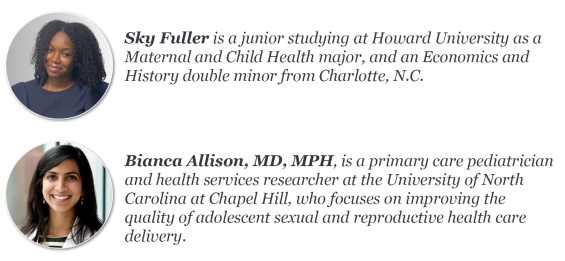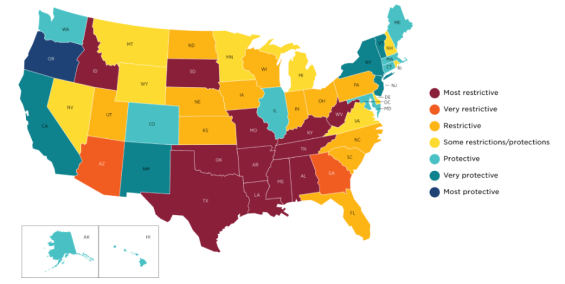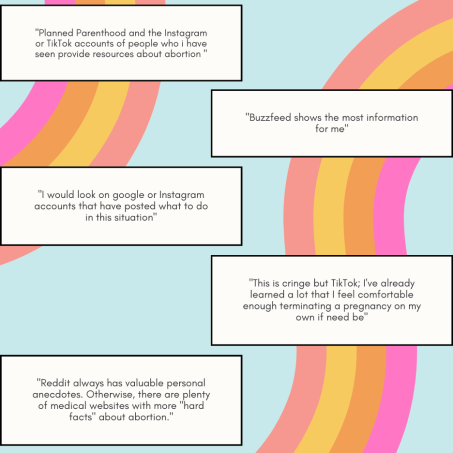Teens Need Access to High-quality, Comprehensive Digital Information About Reproductive Health Options

Editor’s Note: This post is part of an effort to use research and expertise to help other researchers, policymakers, program developers, and institutions understand the downstream effects of limiting youth access to comprehensive reproductive health care. For more, read posts on why access to comprehensive reproductive health care is an adolescent issue and ensuring access to contraception and view a recording of our virtual conversation on centering youth voices in supporting access to comprehensive sexual and reproductive health services.
On June 27, 2022, the U.S. Supreme Court (SCOTUS) issued its decision in Dobbs v. Jackson Women’s Health Organization (JWHO), which overturned Roe v. Wade, and removed federal protection of abortions. Abortion access is now determined by state legislatures, and access depends on where people live.
Abortion policies in effect as of January 29, 2023
Minors (those under 18 years old) are likely to be disproportionately impacted by these changes due to a worsening of many already existing barriers to abortion access such as mandatory consent or parental notification requirements, judicial bypass, high out-of-pocket costs for abortion services, transportation and travel restrictions, and age-restricted telemedicine.
Given the rapidly evolving state laws governing both medication and surgical abortion and already inadequate information access (due to poor sexual health education, and doctors and parents who may not initiate sexual and reproductive health discussions), understanding where teens get information about options for reproductive health care, including abortion, may allow us to develop adolescent-centered interventions that improve access to high-quality information. To do just that, our team has conducted a longitudinal, three-wave nationwide text message-based survey study of 14- to 24-year-olds.
In our first wave of open-ended questions, fielded on May 20, 2022 (18 days after the leaked SCOTUS opinion), we found through the 654 responses we received that adolescents and young adults (AYA) often did not go to clinicians, parents, or teachers for abortion-related information, but rather to the internet and social media. We fielded our second wave of open-ended questions on July 8, 2022 (10 days after the SCOTUS ruling), and the 638 AYA who responded shared more detail about the online sources of information they were aware of. We share those findings and implications here:
Where are teens getting information online?
In our survey, participants most commonly named Planned Parenthood as a resource, with 21% citing this as where they would look if they needed abortion-related information. Planned Parenthood has a prominent voice on social media with more than 1 million followers on Instagram (@plannedparenthood) and more than 350,000 followers on Twitter (@PPFA). The Planned Parenthood website provides tailored resources for teens seeking information about their reproductive health options, with multiple teen-focused pages including up-to-date information on state-by-state legality and abortion funds. They also offer Roo, a sexual and reproductive health chatbot for tailored health information, and a dedicated abortion-finder page.
Few adolescents cited other specific social media accounts or resources, but the sources they did cite included accounts of politicians like Alexandria Ocasio-Cortez (@aoc / @aoc) or influencers (e.g., @so.informed); news outlets such as The New York Times; and advocacy organizations such as Center for Reproductive Rights, Gen Z For Change, Advocates for Youth, or Feminist.com. Several mentioned abortion-specific websites such as National Network of Abortion Funds, Abortionfinder.org, Aid Access, or plancpills.org.
Here’s what teens are saying about these sources for abortion-related information:
How to help teens get reliable information on reproductive health care options
Nearly 40% of surveyed teens could not name specific resources they would use to find abortion information online, stating a social media platform or Google broadly, or answering “don’t know.” Using faulty secondhand sources may thus facilitate the spread of abortion misinformation (i.e., unintentionally false or misleading information about abortion) or disinformation (i.e., intentionally spreading false or misleading information to promote an antiabortion agenda). For example, crisis pregnancy centers—facilities that dissuade pregnant women from accessing certain types of reproductive health care, including abortion care—may look similar to clinics that offer abortion, yet are not a source of comprehensive reproductive health information and pay for ads on social media platforms disproportionately accessed by teens.
Readily accessible misinformation or disinformation may negatively impact teens’ access to accurate, comprehensive abortion information and potentially lead to delays in abortion care or unsafe abortions. So, how can teens get access to high-quality information on abortion?
1. Optimize the places they’re already going
While many adolescents listed social media as a source of information, this alone is not inherently problematic. Social media can be used to spread high-quality, safe information if used intentionally. However, it’s easy for abortion misinformation and disinformation to spread online. It’s critical that we, both as individuals and within our organizations that support teen health, work to ensure teens have access to high-quality, reliable information about all their reproductive health options. In particular:
- Consider that good can come from social media. It is a unique tool actively being used by reproductive justice activists to connect, learn, and mobilize people on a large scale. It can be used to spread and provide high-quality, safe information!
- Amplify information coming from reputable, trusted social media accounts such as Planned Parenthood (@plannedparenthood/@PPFA), Guttmacher (@guttmacherinstitute/@guttmacher), and other clinical or public health sources. Encourage teens to use social media as a starting point to find information about reproductive health services, not the sole source.
- Support or start campaigns (such as one by PlanCPills) to elevate awareness of high-quality and evidence-based sources for abortion-related information. Educators, clinicians, or trusted adults should share reliable websites when talking with young people about getting information about abortion.
- Advocate for limiting the ad distribution of crisis pregnancy centers displayed on Google and social media. Organized efforts have pressured Yelp and Google to separately signal abortion-providing clinics when users search for “abortion clinics near me” (limiting the power of crisis pregnancy centers). However, more work is needed to improve search engines and the algorithmic display of sponsored links first, which are disproportionately paid for by crisis pregnancy centers and may misdirect youth who Google general terms like “abortion clinics near me.”
2. Advocate for better data protection to mitigate privacy concerns
The post-Roe era is fraught with new concerns for data security. Black and Brown individuals have historically borne the brunt of criminalized pregnancy, so the lack of digital privacy protections will have significant implications and likely worsen existing injustices for youth of color.
Laws that criminalize reproductive health are increasingly being used by police and prosecutors to disproportionately surveil, penalize, and control people who are Black and Brown. We need political and technological attention to support the digital freedoms of young people, who we know use the internet for general sexual and reproductive health information-seeking, as well as abortion-specific information, at greater rates.
3. Give guidance on how to search for health information online
In post-Roe America, Google searches, location records and one’s overall digital footprint can be evidence of a crime. Many big tech companies may be slow to change their privacy policies, putting the burden of digital safety on the individual. The U.S. Department of Health and Human Services provides a guide on “Protecting the Privacy and Security of Your Health Information When Using Your Personal Cell Phone or Tablet” as HIPAA rules generally do not protect the privacy or security of health information when it is accessed through or stored on personal cell phones or tablets. Additionally, there are several online checklists and resources (in multiple languages) to assist individuals with protecting their digital privacy.
Since the SCOTUS ruling, anti-abortion activists in abortion-restrictive states are using the opportunity to pass legislation that limits the spread of high-quality information related to reproductive rights. Now more than ever, it is important for young people to understand how and where to get reliable information safely.
Final takeaway
Some companies, such as TikTok, have rapidly evolved in the post-Roe landscape and implemented fact-checking partners for content posted on their platforms, an important first step in improving the quality of online sexual and reproductive health information in the digital spaces where teens are. But, given the pace and volume of content posted every day, it’s important to know and teach young people how to discern facts from misinformation on all social media and search platforms.
As the legal abortion landscape is ever-changing, we need to improve the quality of abortion information teens are readily accessing on social media and Google, uplift content that is comprehensive and factual, and support efforts to guide teens in seeking and finding high-quality sexual and reproductive health information online.




